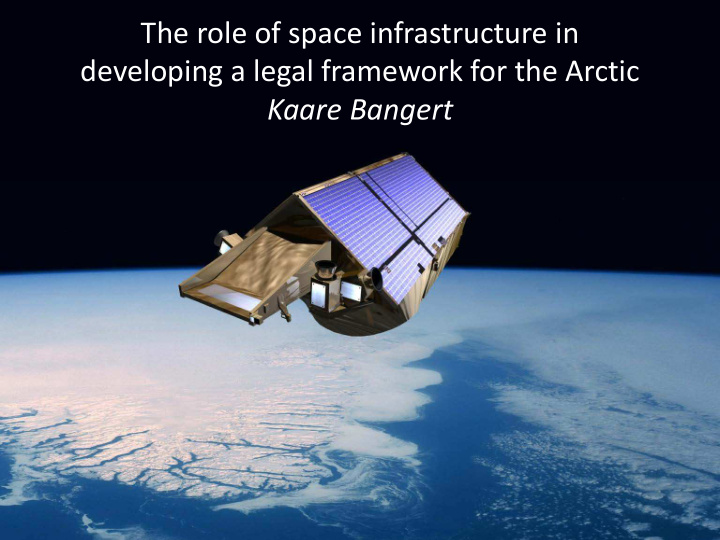



The role of space infrastructure in developing a legal framework for the Arctic Kaare Bangert
Two basic issues for an effective space infrastructure for the new developing Arctic legal regime: 1. The question of technical possibility or legal duty? 2. The question of scientific operational truth and legal applicable truth?
The three legal constituent elements of the new Artic regime: I. Acquisition of sovereignty: 1. By extension of outer limit of maritime jurisdictional zones, as the continental shelf, to a 350+ limit. 2. By delimitation of the maritime zones towards neighbour states. II. Right and duty to effective administration of allocated areas by prescription and enforcement: 1. Navigation: mapping, marking, navigatorial network, routing , SAR etc 2. Exploitation of natural resources: conservation, regulation of activities, protection of oilrigs, pipelines etc. 3. Environment: prevention and repairing of environmental damage etc. 4. General order: peacetime policing and control etc. III. Protection of security of allocated areas: prevention and monitoring of potential threats to maritime and regional security: maritime terrorism, armed conflict etc. The legal basis for this new regime is general international law and treaty law as the 1982 United Nations Convention of the Law of the Sea.
The 1909 Grisbadarna Case (Norway v. Sweden) Whereas, a demarkation which would assign the Grisbadarna to Sweden is supported by all of several circumstances of fact which were pointed out during the discussion and of which the following are the principal ones: a. The circumstance that lobster fishing in the shoals of Grisbadarna has been carried on for a much longer time, to a much larger extent and by much larger number of fishermen by the subjects of Sweden than by the subjects of Norway. b. The circumstance that Sweden has performed various acts in the Grisbadarna region, especially of late, owing to her conviction that these regions were Swedish, as, for instance, the placing of beacons, the measurement of the sea, and the installation of a light- boat, being acts which involved considerable expense and in doing which she not only thought that she was exercising her right but even more that she was performing her duty; whereas Norway, according to her own admission, showed much less solicitude in this region in these various regards. Whereas, as regards the circumstance of fact mentioned in paragraph a above, it is a settled principle of the law of nations that a state of things which actually exists and has existed for a long time should be changed as little as possible; (Source: The 1909 Grisbadarna Case 11 RIAA 161 )
Scientific and legal truth: two conflicting conceptual frameworks? I. Reliable satellite based information: scientifically truth- or operational applicability? II. Legally qualified satellite based information: legal truth-or operational applicability? Article 111 Right of Hot Pursuit 1.The hot pursuit of a foreign ship may be undertaken when the competent authorities of the coastal State have good reason to believe that the ship has violated the laws and regulations of that State. … 4. Hot pursuit is not deemed to have begun unless the pursuing ship has satisfied itself by such practicable means as may be available that the ship pursued or one of its boats or other craft working as a team and using the ship pursued as a mother ship is within the limits of the territorial sea, or, as the case may be, within the contiguous zone or the exclusive economic zone or above the continental shelf. The pursuit may only be commenced after a visual or auditory signal to stop has been given at a distance which enables it to be seen or heard by the foreign ship. (1982 United Nations Law of the Sea Convention)
1. Technical possibility or legal duty? 2. Scientific operational truth and legal applicable truth? Your Questions, please!
Recommend
More recommend